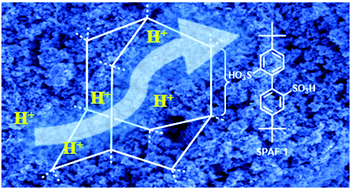Water mediated proton conduction in a sulfonated microporous organic polymer†
Abstract
Polymer membranes (PEMs) within fuel cells (FCs) act as separators and efficient proton conducting electrolytes. Established systems tend to microphase separation into hydrophilic and hydrophobic regions, making these materials prone to water loss at elevated temperatures. Therefore, recent approaches utilize porous materials, which promise stronger interactions between water molecules and the framework, while still providing efficient conductive pathways. Here we show, that the microporous polymer PAF-1 exhibits proton conductivities up to 10−1 S cm−1 under hydrous conditions, after post-synthetic sulfonation. Gas phase sulfonation turned out to be the essential step for introducing a sufficiently large amount of –SO3H groups and thus a high charge carrier concentration upon hydration. While the absolute conductivity of the sulfonated frameworks strongly depends on the water uptake, we found similar activation barriers for all relative humidities. Since water is homogeneously stored in micro- and mesoporous voids, the activation barrier of the interpore conductivity is decisive for the macroscopic properties.



 Please wait while we load your content...
Please wait while we load your content...